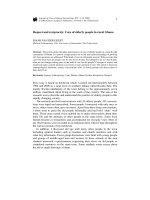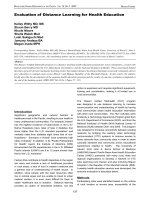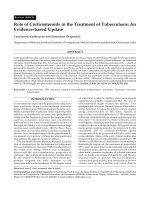Testing of Body Armor Materials Phase III pot
Bạn đang xem bản rút gọn của tài liệu. Xem và tải ngay bản đầy đủ của tài liệu tại đây (15.43 MB, 363 trang )
Testing of Body
Armor Materials
Phase III
THE NATIONAL ACADEMIES PRESS
Copyright © National Academy of Sciences. All rights reserved.
Testing of Body Armor Materials: Phase III
Testing of Body
Armor Materials
Phase III
Committee on Testing of Body Armor Materials for Use by the U.S. Army—
Phase III
Board on Army Science and Technology
Division on Engineering and Physical Sciences
Copyright © National Academy of Sciences. All rights reserved.
Testing of Body Armor Materials: Phase III
THE NATIONAL ACADEMIES PRESS 500 Fifth Street, NW Washington, DC
20001
NOTICE: The project that is the subject of this report was approved by the Governing Board of the
National Research Council, whose members are drawn from the councils of the National Academy of
Sciences, the National Academy of Engineering, and the Institute of Medicine. The members of the
committee responsible for the report were chosen for their special competences and with regard for
appropriate balance.
This material is based upon work supported by the National Science Foundation under Grant No. SES-
0453930, Amendment #012. Any opinions, findings, and conclusions or recommendations expressed
in this material are those of the author(s) and do not necessarily reflect the views of the National
Science Foundation.
International Standard Book Number ISBN-13: 978-309-25599-8
International Standard Book Number ISBN-10: 0-309-25599-6
Limited copies of this report are available from: Additional copies are available from:
Board on Army Science and Technology The National Academies Press
National Research Council 500 Fifth Street, NW
500 Fifth Street, NW, Room 940 Keck 360
Washington, DC 20001 Washington, DC 20001
(202) 334-3118 (800) 624-6242 or (202) 334-3313
Copyright 2012 by the National Academy of Sciences. All rights reserved.
Printed in the United States of America
Copyright © National Academy of Sciences. All rights reserved.
Testing of Body Armor Materials: Phase III
The National Academy of Sciences is a private, nonprofit, self-perpetuating society of distinguished
scholars engaged in scientific and engineering research, dedicated to the furtherance of science and
technology and to their use for the general welfare. Upon the authority of the charter granted to it by the
Congress in 1863, the Academy has a mandate that requires it to advise the federal government on scientific
and technical matters. Dr. Ralph J. Cicerone is president of the National Academy of Sciences.
The National Academy of Engineering was established in 1964, under the charter of the National Academy
of Sciences, as a parallel organization of outstanding engineers. It is autonomous in its administration and in
the selection of its members, sharing with the National Academy of Sciences the responsibility for advising
the federal government. The National Academy of Engineering also sponsors engineering programs aimed at
meeting national needs, encourages education and research, and recognizes the superior achievements of
engineers. Dr. Charles M. Vest is president of the National Academy of Engineering.
The Institute of Medicine was established in 1970 by the National Academy of Sciences to secure the
services of eminent members of appropriate professions in the examination of policy matters pertaining to the
health of the public. The Institute acts under the responsibility given to the National Academy of Sciences by
its congressional charter to be an adviser to the federal government and, upon its own initiative, to identify
issues of medical care, research, and education. Dr. Harvey V. Fineberg is president of the Institute of
Medicine.
The National Research Council was organized by the National Academy of Sciences in 1916 to associate
the broad community of science and technology with the Academy’s purposes of furthering knowledge and
advising the federal government. Functioning in accordance with general policies determined by the
Academy, the Council has become the principal operating agency of both the National Academy of Sciences
and the National Academy of Engineering in providing services to the government, the public, and the
scientific and engineering communities. The Council is administered jointly by both Academies and the
Institute of Medicine. Dr. Ralph J. Cicerone and Dr. Charles M. Vest are chair and vice chair, respectively, of
the National Research Council.
www.national-academies.org
Copyright © National Academy of Sciences. All rights reserved.
Testing of Body Armor Materials: Phase III
Copyright © National Academy of Sciences. All rights reserved.
Testing of Body Armor Materials: Phase III
v
COMMITTEE ON THE TESTING OF BODY ARMOR FOR THE U.S.
ARMY – PHASE III
LARRY G. LEHOWICZ, MG, U.S. Army (ret), Chair, Quantum Research
International, Arlington, Virginia
CAMERON R. BASS, Duke University, Durham, North Carolina
THOMAS F. BUDINGER, NAE/IOM
1
, E.O. Lawrence Berkeley National
Laboratory, Berkeley, California
MORTON M. DENN, NAE. City College of the City University of New York
WILLIAM G. FAHRENHOLTZ, Missouri University of Science and
Technology, Rolla
RONALD D. FRICKER, JR., Naval Postgraduate School, Monterey, California
YOGENDRA M. GUPTA, Washington State University, Pullman
DENNIS K. KILLINGER, University of South Florida, Tampa
VLADIMIR B. MARKOV, Advanced Systems and Technologies, Inc., Irvine,
California
JAMES D. McGUFFIN-CAWLEY, Case Western Reserve University, Cleveland,
Ohio
RUSSELL N. PRATHER, Survice Engineering Company, Bel Air, Maryland
SHELDON WIEDERHORN, NAE, National Institute of Standards and
Technology, Gaithersburg, Maryland
ALYSON GABBARD WILSON, Institute for Defense Analyses, Alexandria,
Virginia
Staff
BRUCE A. BRAUN, Director, Board on Army Science and Technology
ROBERT LOVE, Study Director
HARRISON T. PANNELLA, Senior Program Officer
NIA D. JOHNSON, Senior Research Associate, Board on Army Science and
Technology
JAMES MYSKA, Senior Research Associate, Board on Army Science and
Technology
DEANNA P. SPARGER, Program Administrative Coordinator, Board on Army
Science and Technology
ANN LARROW, Research Assistant
JOSEPH PALMER, Senior Program Assistant
ALICE WILLIAMS, Senior Program Assistant (until September 10, 2010)
CONSTANCE CITRO, Director, Committee on National Statistics
DENNIS CHAMOT, Acting Director, National Materials Advisory Board
JAMES P. McGEE, Director, Army Research Laboratory Technical Assessment
Board
1
NAE/IOM, National Academy of Engineering/Institute of Medicine
Copyright © National Academy of Sciences. All rights reserved.
Testing of Body Armor Materials: Phase III
vi
BOARD ON ARMY SCIENCE AND TECHNOLOGY
ALAN H. EPSTEIN, Chair, Pratt & Whitney, East Hartford, Connecticut
DAVID M. MADDOX, Vice Chair, Independent Consultant, Arlington, Virginia
DUANE ADAMS, Independent Consultant, Carnegie Mellon University (retired),
Arlington, Virginia
ILESANMI ADESIDA, University of Illinois at Urbana-Champaign
EDWARD C. BRADY, Strategic Perspectives, Inc., Fort Lauderdale, Florida
MARY E. BOYCE, Massachusetts Institute of Technology, Cambridge
W. PETER CHERRY, Independent Consultant, Ann Arbor, Michigan
EARL H. DOWELL, Duke University, Durham, North Carolina
JULIA D. ERDLEY, Pennsylvania State University, State College
LESTER A. FOSTER, Electronic Warfare Associates, Herndon, Virginia
JAMES A. FREEBERSYSER, BBN Technology, St. Louis Park, Minnesota
RONALD P. FUCHS, Independent Consultant, Seattle, Washington
W. HARVEY GRAY, Independent Consultant, Oak Ridge, Tennessee
JOHN J. HAMMOND, Lockheed Martin Corporation (retired), Fairfax, Virginia
RANDALL W. HILL, JR., University of Southern California Institute for
Creative Technologies, Playa Vista
JOHN W. HUTCHINSON, Harvard University, Cambridge, Massachusetts
MARY JANE IRWIN, Pennsylvania State University, University Park
ROBIN L. KEESEE, Independent Consultant, Fairfax, Virginia
ELLIOT D. KIEFF, Channing Laboratory, Harvard University, Boston,
Massachusetts
WILLIAM L. MELVIN, Georgia Tech Research Institute, Smyrna
ROBIN MURPHY, Texas A&M University, College Station
SCOTT PARAZYNSKI, University of Texas Medical Branch, Galveston, Texas
RICHARD R. PAUL, Independent Consultant, Bellevue, Washington
JEAN D. REED, Independent Consultant, Arlington, Virginia
LEON E. SALOMON, Independent Consultant, Gulfport, Florida
JONATHAN M. SMITH, University of Pennsylvania, Philadelphia
MARK J.T. SMITH, Purdue University, West Lafayette, Indiana
MICHAEL A. STROSCIO, University of Illinois, Chicago
DAVID A. TIRRELL, California Institute of Technology, Pasadena
JOSEPH YAKOVAC, President, JVM LLC, Hampton, Virginia
Staff
BRUCE A. BRAUN, Director
CHRIS JONES, Financial Manager
DEANNA P. SPARGER, Program Administrative Coordinator
Copyright © National Academy of Sciences. All rights reserved.
Testing of Body Armor Materials: Phase III
vii
Preface
This report is the final volume of a three-phase study commissioned by the
Director of Operational Test and Evaluation (DOT&E) of the Department of
Defense (DoD) to assist in addressing shortcomings that had been reported by the
Government Accountability Office (GAO) and the DoD Inspector General in
DoD’s body armor testing process. Independent committees were empanelled for
the three study phases. Each committee produced an independent report, although
this final Phase III report builds on the results of the letter reports delivered in
Phases I and II, both of which provided findings and recommendations on key
issues that required near-term resolution by DOT&E. The study was conducted
under the auspices of the National Research Council (NRC) Board on Army
Science and Technology (BAST) and Committee on National Statistics.
The Phase I letter report, released in January 2010, addressed the
adequacy of laser instrumentation for evaluating ballistics tests in clay material.
The Phase II report, released in May 2010, focused on the behavior of ballistics
clay used as a recording medium during live-fire testing. The Phase III committee
had more time for meetings and data gathering than the two previous committees
and was able to use the substantial amount of data collected throughout the entire
study. As a result the committee was able to delve more deeply into all available
data than had been possible in the earlier phases of the effort.
This Phase III report provides a wide range of recommendations designed
to help enable the entire body armor community utilize an effective testing
process leading to fielding the best equipment possible that meets performance
specifications while reducing the weight burden placed on soldiers in training or
combat.
The Phase III committee deserves special thanks for its hard work.
Several committee members went well beyond the norm in interviewing
numerous experts, assessing the pertinent issues, and developing
recommendations to address the many demands of the committee’s statement of
task. In particular, committee member Thomas Budinger deserves special credit
for leading the Phase III ad hoc instrumentation committee subgroup that
produced a thoughtful review of the data and information related to
instrumentation. The committee is also grateful to the many DoD, Army, Marine
Corps, industry, and contractor personnel engaged in body armor testing for the
useful information they provided.
Finally, the committee also greatly appreciates the support and assistance
of the NRC staff members who assisted the committee in its fact-finding activities
Copyright © National Academy of Sciences. All rights reserved.
Testing of Body Armor Materials: Phase III
viii
and in the production of the three separate committee reports. In particular, thanks
are due to the BAST staff, principally Bruce Braun, Margaret Novack and Robert
Love, who ably facilitated the committee’s work.
Larry Lehowicz, Chair
Committee on Testing of Body Armor
Materials for Use by the U.S. Army
Copyright © National Academy of Sciences. All rights reserved.
Testing of Body Armor Materials: Phase III
ix
Acknowledgments
This report has been reviewed in draft form by individuals chosen for their
diverse perspectives and technical expertise, in accordance with procedures
approved by the National Research Council Report Review Committee. The
purpose of this independent review is to provide candid and critical comments
that will assist the institution in making its published report as sound as possible
and to ensure that the report meets institutional standards for objectivity,
evidence, and responsiveness to the study charge. The review comments and draft
manuscript remain confidential to protect the integrity of the deliberative process.
We wish to thank the following individuals for their review of this report:
Morris E. Fine (NAE), Northwestern University
John S. Foster, Jr. (NAE), GKN Aerospace Transparency Systems
David Higdon, Los Alamos National Laboratory
Peter Matic, Naval Research Laboratory
Erik Novak, Veeco Instruments,
Henry Smith, (NAE), Massachusetts Institute of Technology
Leslie J. Struble, University of Illinois
Stephen F. Vatner, New Jersey Medical School
Emmanuel Yashchin, IBM Watson Research Center
Laurence R. Young (NAE/IOM), Massachusetts Institute of Technology
Although the reviewers listed above have provided many constructive
comments and suggestions, they were not asked to endorse the conclusions or
recommendations, nor did they see the final draft of the report before its release.
The review of this report was overseen by Lawrence D. Brown, NAS, Wharton
School, University of Pennsylvania, and Arthur H. Heuer, NAE, Case Western
Reserve University. Appointed by the National Research Council, they were
responsible for making certain that an independent examination of this report was
carried out in accordance with institutional procedures and that all review
comments were carefully considered. Responsibility for the final content of this
report rests entirely with the authoring committee and the institution.
Copyright © National Academy of Sciences. All rights reserved.
Testing of Body Armor Materials: Phase III
x
Copyright © National Academy of Sciences. All rights reserved.
Testing of Body Armor Materials: Phase III
xi
Contents
SUMMARY 1
1 INTRODUCTION 20
Background, 20
Study Tasks, 20
Study Context, 22
Study Implementation, 22
Report Organization, 23
References, 24
2 OVERVIEW OF BODY ARMOR 25
Background, 25
Ceramic Plates in Body Armor, 26
Fiber and Resin Composites in Helmets, 26
Survivability vs. Mobility, 27
Medical Study Basis for Testing Body Armor, 27
Body Armor Testing Process, 28
Body Armor Testing Range, 31
Government Accountability Office Report, 32
References, 33
3 HISTORICAL BASIS FOR CURRENT BODY ARMOR TESTING 34
Background, 34
Evolution of Clay Usage, 38
High-Energy Threats, 41
Rifle Threats for Hard Body Armors, 42
Work Performed after the Prather Study, 42
Current Standard, 44
References, 44
4 CLAY AND BACKING MATERIALS 46
Use of Backing Material as a Recording Medium, 46
Characteristics and Properties of RP #1, 51
Behavior in Testing, 51
Influence of Structure on Properties of Oil-Base Modeling Clay, 63
Short-Term Development of an Interim Standard Clay Formulation for
Ballistic Testing, 69
Conditioning and Handling of Clay, 71
Calibration Drop Test, 74
Copyright © National Academy of Sciences. All rights reserved.
Testing of Body Armor Materials: Phase III
xii
Alternative Backing Materials and Systems, 76
Medium-Term and Long-Term Replacements for Modeling Clay, 76
Electronic Recording Systems, 78
Roadmap for Improving the Testing Process, 79
Near-Term Actions, 81
Medium-Term Research Needs, 85
Long-Term Goal, 88
References, 88
5 INSTRUMENTATION AND PROCEDURES FOR MEASURING 92
AN INDENT IN A CLAY BACKING MATERIAL
Conceptual Steps Toward Improvements in The Measurement of BFD, 92
Step One, 92
Step Two, 93
Step Three, 93
Step Four, 93
Steps Five and Six, 94
Instrumentation Performance Based on Statistical Analysis, 94
Overview of Current Instrumentation and Measurements, 96
Coordinate Measuring Machine, 96
Digital Caliper, 96
Faro System, 97
BFD Measuring Procedures, 99
Human Operator Considerations, 99
Compensating for Offset between the Point of
Aim and the Deepest Indent, 101
Variability (Noise) in the Overall Testing Process, 101
Need for a Stand-Alone BFD Artifact or Standard Model for
InterOrganizationVerification, 103
Characteristics of a “Best Utility” Measuring Instrument, 104
References, 106
6 STATISTICAL CONSIDERATIONS IN BODY ARMOR TESTING 107
Introduction, 107
Statistically Principled Testing, 107
Uncertainty and Variation Drive Overdesign, 108
Key Test Protocol Design Requirements, 109
Background, 111
Historical First Article Testing Protocols, 111
DOT&E Protocol for Body Armor FAT, 113
Test Protocol Assumptions, 119
Lot Acceptance Testing, 123
Protocol Design Trade-offs and Comparisons, 128
Recommendations, 132
References, 135
Copyright © National Academy of Sciences. All rights reserved.
Testing of Body Armor Materials: Phase III
xiii
7 HELMET TESTING 137
Ballistic Helmet Test Methodolgies, 137
Injury Modes, 139
Existing Human Injury Criteria, 140
Head Injury from Ballistic Impact, 142
Neck Injury, 143
Helmet Design and Suspension Systems, 145
Existing Helmet Test Methodologies, 146
NIJ Standard 0106.01, 148
Army Clay Head Form, 150
Testing Standards, 151
Test Procedures, 152
H.P. White Laboratory Test Procedure, 157
Peepsite Head Form, 160
UVA Head Form, 163
BLS Head Form, 164
References, 165
8 MEDICAL BASIS FOR FUTURE BODY ARMOR 169
TESTING
Thoracic Ballistic Test Methodologies, 169
Introduction to Behind Armor Blunt Trauma, 169
Ergonomics of Body Armor, 173
Injury Biomechanics, 173
Injury Criteria and Experimentation, 177
Blast Injury Criteria and BlastLike Mechanisms, 183
Low-Rate Blunt Trauma Mechanisms, 185
Human Epidemiology for Battlefield BABT, 185
Injury Scales, 186
Current Epidemiology for Battlefield/Law Enforcement BABT, 191
Large Animal Experiments for Behind-Armor Blunt Trauma, 191
Potential Adverse Effects of Body Armor in Blast Exposures, 206
Cadaveric Experiments for Behind-Armor Blunt Trauma, 209
Rationale for Large-Animal, Live-Fire Experiments, 212
Instrumented Determination of Backface
Deformation—Research Directions, 213
Bulk Tissue Simulants, 215
Instrumented Response Elements, 215
Instrumented Detailed Anatomical Surrogates, 221
Developmental Testing Requirements, 225
Medical Research Needs, 229
Near-Term Actions, 229
Medium-Term Actions, 230
References, 231
Copyright © National Academy of Sciences. All rights reserved.
Testing of Body Armor Materials: Phase III
xiv
9 FUTURE IMPROVEMENTS IN TESTING METHODOLOGY 240
Building on the Prather Study, 240
Synopsis of Near-Term Improvements, 241
Linking Medical Research Data to Product Testing Criteria, 244
Dynamics and Measurement of Behind-Armor Forces, 244
Synchronizing the Stakeholders, 248
Military and Law Enforcement Personnel, 249
Technologists, 250
Medical Researchers, 250
Testers—Developmental and Operational, 250
Aligning Stakeholders, 251
Establishing National Standards, 252
References, 254
APPENDIXES
A Biographical Sketches of Committee Members 257
B Committee Meetings 264
C Additional Phase III Tasks 268
D Report Sections Cross-Referenced to the Statement of Task 269
E Ballistic Body Armor Insert Composition and Defeat Mechanisms 272
F Committee Responses to the Government Accountability 274
Office Report
G Determining the Necessary Level of Precision for 280
Body Armor Testing
H Statistical Tolerance Bounds 299
I Analytical Approaches for Comparing Test Protocols 302
J Contemporary Methods for Assessing Behind-Armor 305
Blunt Trauma in Live Animals
K Phase I Findings 316
L Phase II Recommendations 317
M Estimating the Accuracy and Precision of the 323
Digital Caliper and Faro Laser
Copyright © National Academy of Sciences. All rights reserved.
Testing of Body Armor Materials: Phase III
xv
Tables, Figures, and Boxes
TABLES
3-1 Strengths and Weaknesses of the Prather Methodology, 45
4-1 Elastic Recovery in Modified Charpy Testing of Oil-Based
Modeling Clay, 49
6-1 60-Plate Protocol, 115
6-2 Proposed FAT Standards, 117
6-3 Proposed LAT Standards, 124
6-4 Risk Comparisons for Probability of Complete Penetration, 129
7-1 Characteristics of Test Rounds from NIJ Standard-0106.01, 149
7-2 H.P. White Laboratory Test Procedure, 158
7-3 Helmet Test Matrix, 161
8-1 Muzzle Parameters for Various Types of Rounds, 170
8-2 Energy/Momentum for Various Typical Thoracic Trauma Situations, 171
8-3 Description of Levels of Thoracic Trauma, 186
8-4 Combat Effectiveness vs. Levels of Thoracic Trauma, 187
8-5 Bullet Specifications and Injury Outcome, 194
9-1 Strengths and Weaknesses of the Prather Methodology, 241
FIGURES
S-1 Road map showing suggested near-term actions, medium-term research
needs, and a long-term goal to develop a more consistent backing material
and a more reliable process for evaluating hard armor, 8
S-2 Road map showing suggested near-term and medium-term research needs,
and a long-term goal to provide the fundamental medical basis for injury
risk assessment behind helmets and hard body armor, 17
2-1 The clay appliqué applied to the clay box, 29
2-2 Surface of the BFD as measured by a laser scanning system, 30
2-3 The body armor test range at ATC, 32
3-1 Overview of development of Prather clay methodology, 35
Copyright © National Academy of Sciences. All rights reserved.
Testing of Body Armor Materials: Phase III
xvi
3-2 Blunt deformation profiles into gelatin using seven-ply K29 armor
samples mounted on gelatin and tested with the .38-cal LRN bullet at 213
m/sec (800 ft/sec), 37
3-3 Deformation depth vs. time of candidate materials in a goat thorax using a
blunt impactor at 55 m/sec, 39
3-4 Logistic regression model of death vs deformation for blunt impact into
goat chests, 39
3-5 Logistic regression model of death vs. deformation for blunt impact into
clay using deformation response into goat chests and clay, 41
3-6 Clay deformation behind hard armor with rifle round threats, 42
3-7 Variation of clay penetration depth with velocity for behind-body armor
deformation (7.62-mm NATO round, UHMWPE body armor), 43
3-8 Variation of clay penetration area with velocity for behind-body armor
deformation (7.62-mm NATO round, UHMWPE body armor), 43
4-1 A schematic illustration of the stress-strain curves
for two idealized solids, 47
4-2 A contour gage in use, 48
4-3 Column drop test as performed at ATC, 53
4-4 The results of drop tests on clay boxes allowed to naturally cool from
40°C in a room at normal room temperature (roughly 23°C), 55
4-5 Drop test results using the standard Army right-circular cylinder with a
solid hemispherical cap (44.5 mm [1.75 in.] in diameter with a mass of 1
kg [2.2 lb]), a similar non-standard double-length cylinder of the same
diameter with the same type of hemispherical cap, and sphere with the
diameter specified in the National Institute of Justice Standard (NIJ ), 63.5
mm (2.5 in.) in diameter, 56
4-6 Spatial pattern used in a series of experiments to determine the effect of
position on the size of the cavity produced during a drop test, 57
4-7 Illustrative results from a study on the effect of radial position on depth of
penetration during a drop calibration test, 58
4-8 A clay box used for .32-cal rubber sting ball testing, 61
4-9 Results of sting ball experiments with projectiles ranging from 55 m/sec
(180 ft/sec) to 168 m/sec (550 ft/sec), 62
4-10 A schematic illustration of the “thixotropic cycle” of a
two-phase system, 65
4-11 Optical micrographs of a three-dimensional network of spherical latex
particles, 66
4-12 Road map showing suggested near-term actions, medium-term research
needs, and a long-term goal to develop a more consistent backing material
and a more reliable process for evaluating hard armor, 81
5-1 Digital calipers used in armor testing, 97
5-2 Faro Quantum laser scan arm, 98
6-1 USSOCOM FAT shot pattern, 113
Copyright © National Academy of Sciences. All rights reserved.
Testing of Body Armor Materials: Phase III
xvii
6-2 Plot of the actual coverage level achieved by a lower confidence bound
calculated according to the Clopper-Pearson method for n = 60 and
various Pr(nP), 122
6-3 Probability a lot passes LAT first shot requirements for Pr(nP) for the S-4
and S-3 inspection levels for various lot sizes
and an AQL of 4 percent, 126
6-4 Probability a lot passes LAT second shot requirements for Pr(nP) for the
S-4 and S-3 inspection levels for various lot sizes
and an AQL of 4 percent, 127
6-5 Plot of the manufacturer’s risk for various Pr(nP) under the DOT&E
protocol, 130
6-6 Risk comparisons for BFD assuming in the left plot that the
manufacturer’s true mean BFD is 38 mm and in the right plot is 40 mm;
the associated fraction of variation is shown on the x-axis, 131
7-1 Effective momentum of high-rate ballistic impacts at muzzle velocity and
low-rate football impact, 138
7-2 Ballistic impact injury time scales, 138
7-3 Likeness of a deformed personnel armor system for ground troops
(PASGT) helmet, 139
7-4 Cadaver instrumentation overview, 142
7-5 Neck injury assessment value for 9-mm FMJ test round at various
velocities into helmeted human cadavers, 144
7-6 Residual head/neck velocity from momentum transfer to the helmet/head
system, 145
7-7 Impact energy for helmet standards, 147
7-8 Ballistic (high-rate) skull fracture data vs. impact injury criteria for typical
blunt injury, 147
7-9 NIJ sagittal penetration head form, 148
7-10 Army clay head form, 150
7-11 ATC head form with clay, 153
7-12 Head form clay conditioning by analogy, 154
7-13 Test impact locations, 156
7-14 Test frame, 157
7-15 H.P. White head form, 159
7-16 Peepsite head forms: different head forms for different shot directions, 160
7-17 Left, UVA head form; right, risk assessment, 163
7-18 BLS head form, 164
7-19 Arrangement and dimensions of load cells in the BLS head form, 165
8-1 Initial energy and momentum for ballistics and other blunt impacts, 171
8-2 Superimposed high speed X-rays of the initial shock wave and
deformation of the thorax during a 7.62 mm projectile live fire test in a pig
protected by hard body armor, 172
8-3 Development of surrogate injury model, 175
8-4 Volunteer experimentation, 177
Copyright © National Academy of Sciences. All rights reserved.
Testing of Body Armor Materials: Phase III
xviii
8-5 Human upper torso, 179
8-6 Threshold pressures and exposure times needed to damage drosophila
larvae using various loading devices, 180
8-7 Threshold damage for various tissues, 181
8-8 ASII values versus peak inward chest wall velocity, 183
8-9 Overpressure/duration blast injury criteria, 184
8-10 Kinetic energy vs. injury severity, 188
8-11 Time of delivery of wounded to the CMH (average 1983-1984), 189
8-12 Severity of wounds for patients delivered to the CMH (average 1983-
1984), 190
8-13 Lateral dog thorax impacted by nonpenetrating missiles, 192
8-14 Impact energy (scaled to a 75 kg man) vs. increased lung mass, 193
8-15 Body armor for Oksboel trials, 196
8-16 Average first and second peak pressure, Oksbøl trials, 197
8-17 Average postmortem lung mass, Oksbøl trials, 198
8-18 Oksboel first peak on Bowen curve, 199
8-19 Animal fatalities during monitoring period, 201
8-20 BABT flash X-ray, 202
8-21 Relationship between area of lung surface contusion and maximum back-
face deformation of body armor, 202
8-22 Relationship between area of lung surface contusion and pressure 6 cm
from point of impact, 203
8-23 Examples of BABT assessment devices and methodologies, 214
8-24 DERA BABT simulator displacement sensor system, 216
8-25 DERA concept of viscoelastic tissue stimulant as described by
Mirzeabassov, et al., 2000, 218
8-26 Hybrid III 50th percentile male dummy, 219
8-27 ATM with mounted body armor; ATM instrumented response element
with padding, 220
8-28 Human CT scan; finite-element model, 221
8-29 AUSMAN upper torso, 222
8-30 AUSMAN thorax with body armor in place, prior to testing, 223
8-31 Road map showing suggested near-term and medium-term research needs,
and a long-term goal to provide the fundamental medical basis for injury
risk assessment behind helmets and hard body armor, 228
9-1 Road map showing suggested near-term actions, medium-term research
needs, and a long-term goal to develop a more consistent backing material
and a more reliable process for evaluating hard armor, 242
9-2 Flow chart showing suggested near-term and mid-term research needs, and
a long term goal to provide the fundamental medical basis for injury risk
assessment behind helmets and hard body armor, 243
9-3 Schematic of conceptual approach used by both testers and researchers
showing a projectile impacting normally onto hard body armor (A), soft
body armor (B), and a recording medium surrogate for a
human body (C), 244
Copyright © National Academy of Sciences. All rights reserved.
Testing of Body Armor Materials: Phase III
xix
9-4 Schematic of the dynamic measurement method, 246
9-5 Schematic of stakeholder relationships, 249
G-1 Plot of normally distributed BFDs from a design that just meets the 90%
upper tolerance limit requirement with
pop
= 42.7 mm and with
pop
= 1
mm, 281
G-2 The consequence of measurement error on the apparent
depths of BFDs, 282
G-3 The relationship between measurement error and the overall variance in
armor testing, 286
G-4 How improving the performance of armor relates to the probability of
passing FAT assuming a lot size of 60 plates, 289
G-5 Plot of the difference between the two FAT failure curves, 291
G-6 Photograph, laser scan, and cross section of cavity in RP #1 produced by
armor testing, 293
G-7 Digital calipers used in armor testing, 294
G-8 Two images of typical BFD cavities in RP #1 produced by the Faro laser
scanner, 295
G-9 The probability a manufacturer will pass the first article, first shot BFD
test (solid line) for various population mean BFD levels () versus the
probability that a plate will have a BFD greater than 50 mm from the same
population (dotted line), 297
H-1 Ninety-fifth quintile distribution, 300
J-1 Comprehensive protocol for live-animal live-fire tests, 306
M-1 Plot of the paired BFD measurements made by ATC, 324
M-2 Plot of the paired BFD measurements made by Chesapeake Testing, 324
M-3 Absolute value of offsets for caliper measurements from
Realistic Clay III, 330
BOXES
S-1 Statement of Task, 2
1-1 Original Statement of Task for Phases I, II, and III, 21
L-1 Phase II Recommendations to Improve Body Armor Testing, 321
Copyright © National Academy of Sciences. All rights reserved.
Testing of Body Armor Materials: Phase III
xx
Copyright © National Academy of Sciences. All rights reserved.
Testing of Body Armor Materials: Phase III
xxi
Acronyms and Abbreviations
AIS abbreviated injury scale
AP armor piercing
AQL acceptance quality level
ARDS adult respiratory distress syndrome
ARL U.S. Army Research Laboratory
ASTM A merican Society of Testing and Materials
ATC U.S. Army Aberdeen Test Center
ATD anthropometric test device
ATM anthropomorphic test module
BABT behind-armor blunt trauma
BFD backface deformation
BLS ballistic load sensing
CMH central military hospital
CMM co-ordinate measuring machine
DAI diffuse axonal injury
DERA Defense Evaluation and Research Agency
DGA Délégation Générale pour L'Armement
DoD Department of Defense
DOT&E Office of the Director, Operational Test and Evaluation
DREV Defense Research Establishment Valcartier
ECG electrocardiogram
ESAPI enhanced small arms protective insert
FAT first article testing
FMJ full metal jacket
GAO Government Accountability Office
HIC head injury criteria
IG Inspector General
ISS injury severity score
Copyright © National Academy of Sciences. All rights reserved.
Testing of Body Armor Materials: Phase III
xxii
kPa kilopascal
LAT lot acceptance testing
LRN lead round nose
MPa megapascal
NATO North Atlantic Treaty Organization
NIJ National Institute of Justice
NIST National Institute of Standards and Technology
NRC National Research Council
PEO-S U.S. Army Program Executive Office Soldier
RCC right circular cylinder
RP #1 Roma Plastilina #1
TAB trauma-attenuating backing
TBI traumatic brain injury
TOP test operating procedure
UHMWPE ultra-high molecular weight polyethylene
USSOCOM United States Special Operations Command
UVA University of Virginia
XSAPI X Small Arms Protective Inserts
Copyright © National Academy of Sciences. All rights reserved.
Testing of Body Armor Materials: Phase III
1
Summary
In 2009, the Government Accountability Office (GAO) released the report
Warfighter Support: Independent Expert Assessment of Army Body Armor Test
Results and Procedures Needed Before Fielding, which commented on the
conduct of the test procedures governing acceptance of body armor vest-plate
inserts worn by military service members (GAO, 2009). This GAO report, as well
as other observations—for example, the Army Audit Agency report to the
Program Executive Officer Soldier on Body Armor Testing (AAA, 2009)—led
the Department of Defense (DoD) Director, Operational Test & Evaluation
(DOT&E) to request that the National Research Council (NRC) Division on
Engineering and Physical Sciences conduct an ad hoc study to investigate issues
related to the testing of body armor materials for use by the U.S. Army and other
military departments. Box S-1 contains the statement of task for the three-phase
study. Phases I and II resulted in two NRC letter reports: one in 2009 and one in
2010.
1
This is the Phase III report.
1
Findings and recommendations from the Phase I and Phase II reports are in Appendixes
K and L respectively.
Copyright © National Academy of Sciences. All rights reserved.
Testing of Body Armor Materials: Phase III
2
Box S-1 Statement of Task
The National Research Council will convene specialists in committee form to consider the
technical issues relating to the testing of body armor. To do this the National Research Council
shall conduct a 3-phase study:
In Phase I a committee will comment on the validity of using laser-profilometry/ laser-
interferometry techniques to determine the contours of an indent made by a ballistic test in a non-
transparent clay material at the level of precision established in the Army’s procedures for testing
personal body armor. If laser-profilometry / laser-interferometry is not a valid method, the
committee will consider whether a digital caliper can be used instead to collect valid data. The
Committee will also provide interim observations regarding the column drop performance test
described by the Army for assessing the part to part consistency of a clay body used in testing
body armor. The committee will prepare a letter report documenting the findings from its Phase I
considerations. This is a six week effort beginning November 1 2009 and ending mid December
2009.
In Phase II a committee will consider in greater detail the validity of using the column drop
performance test described by the Army for assessing the part-to-part consistency of a clay body
within the level of precision that is identified by the Army test procedures. The committee will
prepare a letter report documenting the findings from its Phase II considerations. This is a three
months effort beginning November 1 2009 and ending early February 2010.
In Phase III a committee will consider test materials, protocols and standards that should be used
for future testing of personal armor by the Army. The committee will also consider any other
issues associated with body armor testing that the committee considers relevant, including issues
raised in the Government Accountability Office Report Warfighter Support, Independent Expert
Assessment of Body Armor Test Results and Procedures Needed Before Fielding (GAO-10-
119).The committee will prepare a final report. This is a 14-months effort beginning November 1
2009 and ending January 2011.
The final report will document the committee’s findings pertaining to the following issues that are
of particular immediate concern to DOT&E including the following:
The best methods for obtaining consistency of the clay, and of conditioning and calibrating the
clay backing used currently to test armor.
The best instrumentation (e.g., laser scanning system, digital caliper, etc.) and procedures to
use to measure the back face deformation (BFD) in the clay.
The appropriate use of statistical techniques (e.g., rounding numbers, choosing sample sizes, or
test designs) in gathering the data.
The appropriate criteria to apply to determine whether body armor plates can provide needed
protection to soldiers; this includes the proper prescription for determining whether a test results in
a partial or complete penetration of body armor, including, as appropriate, the soft armor
underlying hard armor.
The final report will also document the committee’s findings regarding any other issues regarding
body armor testing that the committee found relevant. The study team will have access to all data
with respect to body armor testing that the team needs for the conduct of the study.









